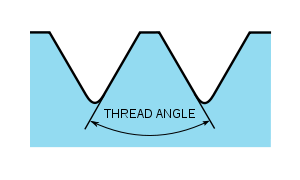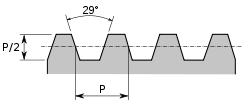Thread angle

Diagram of a thread angle
The thread angle of a screw is the angle between the threads.[1] This is a defining factor for the shape of a screw thread. Standard values include:
| Thread standard | Thread angle | Profile | Letter code | Standards |
|---|---|---|---|---|
| Most V-threads (including ISO, NPT and UTS) | 60° |  | M | DIN 13 / ISO ? / ASME/ANSI ? |
| Whitworth threads | 55° |  | W | DIN 49301 / BS ? |
| Pipe thread British standard pipe thread | 55° |  | G | DIN / BS / EN / ISO 228-1 / ISO 7-1 |
| Knuckle thread / round thread[2][3][4] | 30° |  [5] [5] | Rd | DIN 405 / DIN 20400 |
| Acme thread[6] | 29° |  | ? | ASME/ANSI B1.5-1988[7] |
| Metric trapezoidal threads[1] | 30° |  | Tr | DIN 103 |
| Buttress threads[6] | 45° |  | S | DIN 2781 |
| German Buttress threads[6] | 30° |  | S | DIN 513 |
| Square threads[1] | 0° |  | Sq | ? |
| Steel conduit thread aka Panzergewinde | 80° |  | Pg | DIN 40430 |
| Löwenherz thread[8] | 53° 8' | ? | ? | ? |
| Bodmer thread [9] | 50° | ? | ? | ? |
References
Notes
- ↑ 1.0 1.1 1.2 Bhandari 2007, p. 203.
- ↑ Knuckle Thread DIN 405
- ↑ Knuckle Thread DIN 20400
- ↑ Bornemann
- ↑ Knuckle thread
- ↑ 6.0 6.1 6.2 Bhandari 2007, p. 204.
- ↑ Green 1996, p. 1716.
- ↑ Löwenherz thread
- ↑ Bodmer thread
Bibliography
- Bhandari, V B (2007), Design of Machine Elements, Tata McGraw-Hill, ISBN 978-0-07-061141-2.
- Green, Robert E. et al. (eds) (1996), Machinery's Handbook (25 ed.), New York, NY, USA: Industrial Press, ISBN 978-0-8311-2575-2.